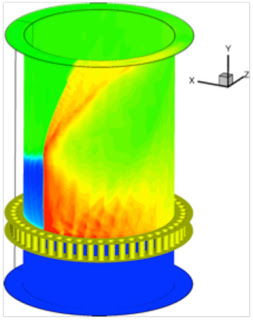

| Visitors Now: | |
| Total Visits: | |
| Total Stories: |

| Story Views | |
| Now: | |
| Last Hour: | |
| Last 24 Hours: | |
| Total: | |
Navy Researchers Look to Rotating Detonation Engines for 25% fuel savings
From
The U.S. Navy finds gas-turbine engines attractive because they scale nicely to large powers, are relatively small and self-contained, and are relatively easy to maintain. The gas-turbine engines the Navy uses today are based on the Brayton thermodynamic cycle, where air is compressed and mixed with fuel, combusted at a constant pressure, and expanded to do work for either generating electricity or for propulsion. To significantly improve the performance of gas-turbine engines, researchers need to look beyond the Brayton cycle to explore alternative and possibly more innovative cycles.
NRL researchers believe that one attractive possibility is to use the detonation cycle instead of the Brayton cycle for powering a gas-turbine.
NRL researchers believe that RDEs (Rotating Detonation Engine) have the potential to meet 10% increased power requirements as well as 25% reduction in fuel use for future Navy applications. Currently there are about 430 gas turbine engines on 129 U.S. Navy ships. These engines burn approximately 2 billion dollars worth of fuel each year. By retrofitting these engines with the rotating detonation technology, researchers estimate that the Navy could save approximately 300 to 400 million dollars a year.
NRL researchers have constructed a model of a Rotating Detonation Engine.(Photo: U.S. Naval Research Laboratory)
See more and subscribe to NextBigFuture at 2012-11-02 16:04:35 Source: http://nextbigfuture.com/2012/11/navy-researchers-look-to-rotating.html
Source:



